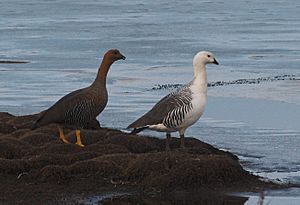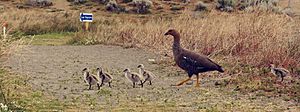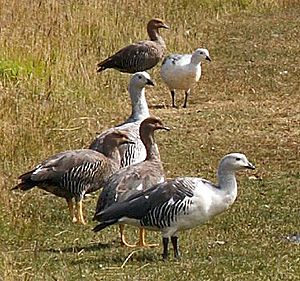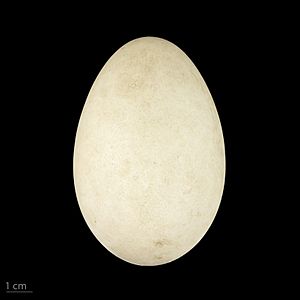Upland goose facts for kids
Quick facts for kids Upland goose |
|
|---|---|
 |
|
| Female (left) and male (right) in Argentina | |
| Conservation status | |
| Scientific classification | |
| Genus: |
Chloephaga
|
| Species: |
picta
|
| Subspecies | |
|
|
| Synonyms | |
|
Foetopterus ambiguus |
|
The upland goose or Magellan goose (Chloephaga picta) is a type of bird that looks like a mix between a duck and a goose. It's part of the Anatidae family, which includes all ducks, geese, and swans.
There are two main types, or subspecies, of the upland goose. The smaller one, called picta or the lesser Magellan goose, lives on the mainland. You can find it from central Chile and south-central Argentina all the way down to Tierra del Fuego. The larger type, leucoptera or the greater Magellan goose, lives on the Falkland Islands off the coast of southern South America.
Contents
What Does the Upland Goose Look Like?

These geese are about 60 to 72.5 centimeters (23 to 28 inches) long. They weigh between 2.7 and 3.2 kilograms (about 6 to 7 pounds).
Male upland geese have white heads and chests. Females are brown with black stripes on their wings and yellow feet. Sometimes, people might confuse females with ruddy-headed geese. Adult males also have a special greenish-bronze patch on their inner wing feathers.
Interestingly, Charles Darwin, a famous scientist, wrote about the upland goose in his book On the Origin of Species. He noticed that these geese have webbing between their toes. He thought this webbing was a vestigial feature. This means it's a body part that was useful to their ancestors but isn't really needed by the geese today.
Where Do Upland Geese Live?

Upland geese live in southern parts of South America. They like grassy areas, dry lowlands, pastures, and farms. You can find them from sea level up to about 1,500 meters (almost 5,000 feet) high. There's also a group of these geese that were brought to the sub-Antarctic South Georgia Island, where they now live.
Upland Goose Behavior and Diet
Upland geese are mostly plant-eaters. They enjoy munching on seeds, leaves, stems, and other plant parts. They are very social birds and often gather in huge groups. You might see thousands of them grazing together in one field!
Farmers sometimes see them as pests because they eat the grass meant for cattle and sheep.
Reproduction and Life Cycle
Upland geese usually build their nests in areas with lots of plants, either on flat plains or on slopes. They often choose spots near water. They mostly breed in September and October, but on the Falkland Islands, they might breed in November.
When a male wants to attract a female, he whistles loudly. The female responds with softer cackling sounds. These geese are monogamous, meaning they stay with one partner. If another male tries to enter a pair's territory, a serious fight can happen. Males have even been found injured or dead after these fights.
The nest is built on the ground and hidden by thick plants. A female usually lays 5 to 8 eggs. She sits on them for about one month until they hatch. When the chicks hatch, they are covered in soft, greyish-brown feathers. They don't stay in the nest for long, usually less than a day. They quickly move to a nearby water source or feeding area. The chicks can find their own food right after they hatch! They learn to fly in about 9 to 10 weeks and become adults when they are 3 years old.
See also
 In Spanish: Cauquén común para niños
In Spanish: Cauquén común para niños



